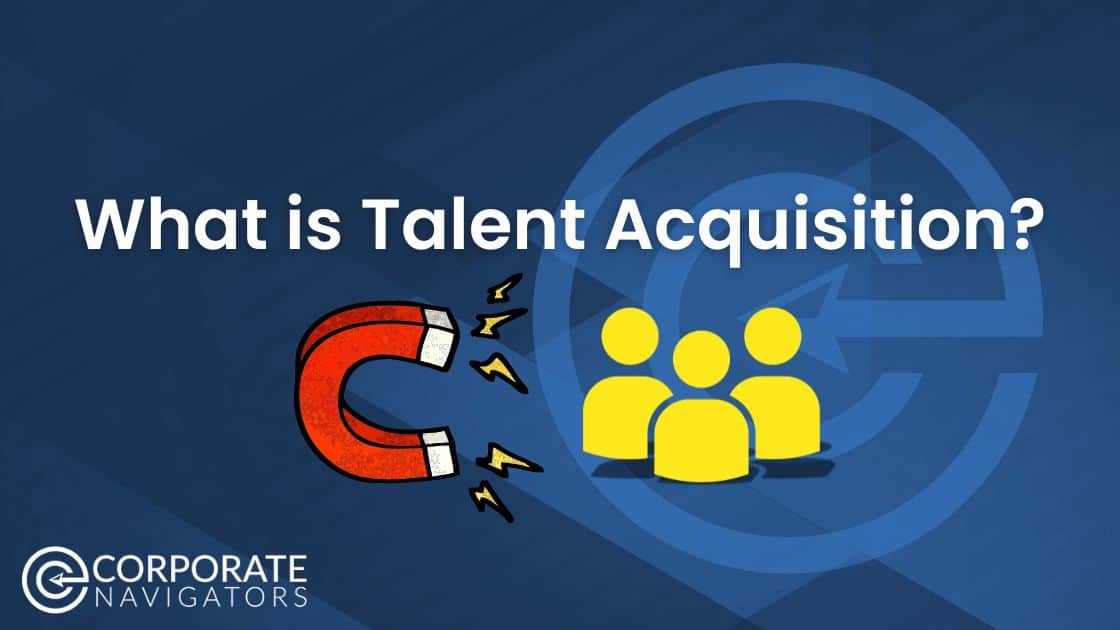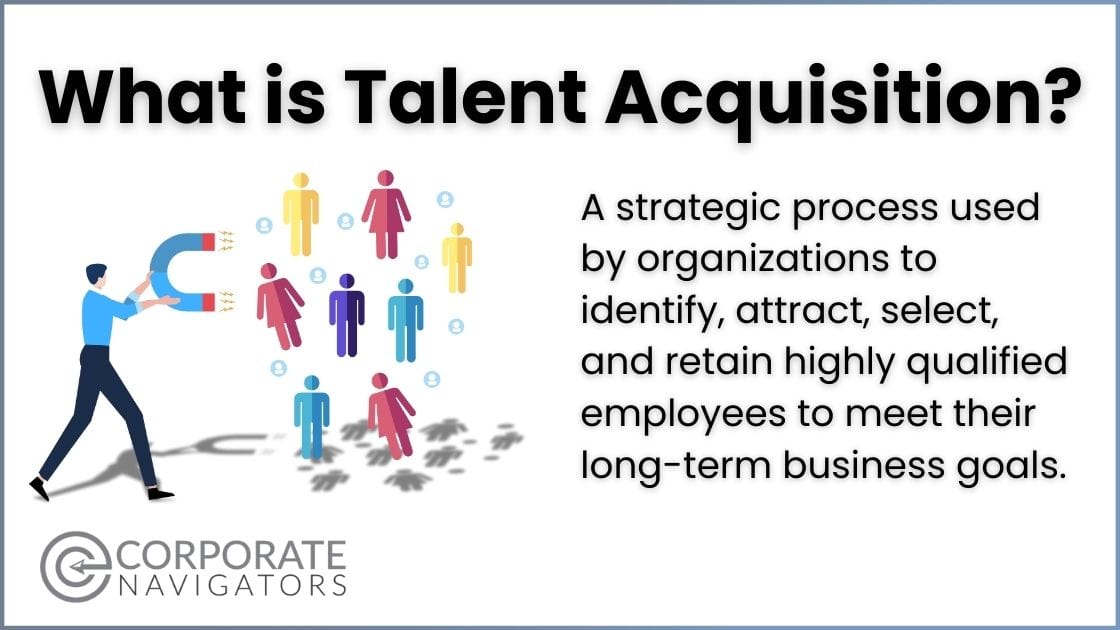
Table of Contents
What is Talent Acquisition?
Talent Acquisition (TA) is a strategic process used by organizations to identify, attract, select, and retain highly qualified employees to meet their long-term business goals. It goes beyond traditional recruitment by building relationships with potential candidates and developing a talent pipeline for future organizational needs.
While you’ll often see “recruitment” and “talent acquisition” used interchangeably, there’s a key difference between them. Recruitment typically focuses on the immediate, transactional task of filling open roles—think of it as putting out fires when they spark up. Talent acquisition, on the other hand, is about the bigger picture: it’s a holistic, ongoing strategy designed to ensure your organization is always ready to meet future talent needs. This means investing in activities like sourcing, employee referrals, nurturing talent pools, and building a strong employer brand—elements that help your company attract the right people, not just fill empty chairs.
At Corporate Navigators, we cover the full cycle of talent acquisition through two key services: recruiting research, in which we identify qualified candidates, and candidate sourcing, in which we contact candidates to screen for interest and other factors our clients request.
Key Components of Talent Acquisition:
- Strategic Approach: It’s a long-term strategy that aligns with an organization’s overall goals and involves workforce planning. It’s not a one-and-done job but requires continuous effort and consideration.
- Employer Branding: To attract the talent you want, you need to be a company candidates want to work for. Developing a strong employer brand positions you to attract top talent and showcase the company as a desirable workplace.
- Talent Pipeline Building: Also known as a candidate pipeline, this process involves continuously building a pool of potential candidates for future positions, often before they become available.
- Candidate Experience: Providing a positive experience for candidates throughout the hiring process to enhance the company’s reputation and make it easier to attract talented candidates for onboarding.
- Legal Compliance: With so many moving parts, it’s important to make sure you’re always in compliance. Hire legal help to ensure all hiring practices comply with local, state, and federal laws to maintain fairness and equity.
Recruitment vs. Talent Acquisition
Unlike recruitment—which is often reactive and focused on filling a vacancy as quickly as possible—talent acquisition is proactive and future-focused. Recruitment might get someone in the door, but talent acquisition ensures you’re building a workforce that will help your company innovate and thrive in the long run. As the talent landscape has evolved, candidates now have more choice and access to information than ever before. Most organizations find that relying on traditional recruitment simply isn’t enough if they want to remain competitive, innovative, and successful. Talent acquisition prioritizes building relationships and anticipating future needs, giving your organization a distinct edge.
Why is Talent Acquisition Important?
This process is crucial for companies because it directly impacts business performance. By ensuring the right people are in the right roles, organizations simply run better. In the long run, effective talent acquisition strategies lead to improved productivity, reduced turnover rates, and an enhanced company culture, all of which contribute to a more engaged and motivated workforce.
By attracting top talent, companies can foster innovation, improve customer service, and gain a competitive edge, ultimately boosting business performance and driving sustainable growth. A strategic approach to talent acquisition also helps build diverse and inclusive teams, streamline the hiring process, and reduce recruitment costs.
Talent Acquisition vs. Recruitment:
- Recruitment is a more tactical process focused on filling immediate vacancies efficiently. It usually refers to a short-term goal that is a one-time deal. This can be ideal for occasional hiring needs that are last-minute and urgent.
- TA is a strategic process that considers long-term needs and cultural fit, aiming to build a strong workforce for future success. It has a company’s future talent needs in mind, often incorporating talent pipelines and building candidate relationships to prepare for future role openings.
Overall, talent acquisition is a comprehensive approach to hiring that emphasizes long-term planning, relationship-building, and strategic alignment with organizational goals.
What are the key strategies in TA?
- Developing a strong employer brand: Did you know that 95% of Gen Z checks a company’s brand reputation before deciding to work for them? This makes a solid brand reputation a must in the future of talent acquisition. Create a compelling image of your organization as an attractive workplace to draw in top talent.
- Implementing strategic sourcing: Use targeted sourcing channels to connect with a wider pool of potential candidates, including job boards, social media, and employee referrals. Hiring Corporate Navigators to source candidates and call into companies for even more information will provide even more candidate options.
- Leveraging technology: Technology can save you a lot of time with the basic tasks of recruiting that used to take up a lot of time, such as screening resumes, online profiles, and more. Utilize applicant tracking systems (ATS), AI-powered tools, and other recruitment technologies to streamline the hiring process and improve efficiency.
- Focusing on the candidate journey: An excellent candidate journey is critical to retaining candidates in the application/screening process and after they are hired. To do so, provide a positive experience for candidates throughout the hiring process, including clear communication, timely feedback, and a user-friendly application process.
- Use data-driven insights: With feedback, you can continue to improve on your practices. Employ analytics to make informed decisions, optimize recruitment processes, and improve the quality of hires. Review periodically to see what is effective and what you need to change in your strategy.
- Prioritizing diversity, equity, and inclusion (DEI): To Gen Z, the most diverse generation yet, diversity and inclusion are strong motivators to join a company. This means that using DEI initiatives to build diverse teams can lead to more candidate choices.
- Building talent pipelines: Develop relationships with potential candidates for future positions, even before they become available. Also known as candidate pipelines, this list of candidates is already vetted for their qualifications and interests, saving you time when a job posting opens.
- Personalizing outreach: In the talent acquisition process, engage prospects with personalized messaging to increase the effectiveness of recruitment efforts. This helps your talent pool feeling connected and valued.
- Collaborating internally: A great recruitment strategy doesn’t just focus on external hiring. Plenty of talent can be found within your company through upskilling or reskilling employees into different departments. In this way, you can work with various stakeholders, including hiring managers and team members, to identify the people internally who have the right skills and cultural fit for open positions.
These strategies collectively form a comprehensive approach to talent acquisition, focusing on long-term organizational success rather than simply filling immediate vacancies.

How can companies assess and improve their talent acquisition maturity?
Just like building a strong talent pipeline, improving your talent acquisition maturity is a continuous journey—and it starts with an honest assessment of where your organization stands today. Companies typically move through several stages as they refine and enhance their hiring practices.
1. Recognize your current state:
- Chaotic: Hiring is reactive, processes are unclear, and results are unpredictable.
- Inconsistent: You see occasional recruiting wins, but there’s no repeatable system in place.
- Systematic: Hiring practices are well-organized and consistently applied, leading to reliable results.
- Strategic: Hiring is both efficient and adaptable, with data-driven improvements and intentional alignment to broader business goals.
2. Evaluate your core competencies:
Ask yourself:
- Are you providing a seamless and positive experience for every candidate?
- Can your team reliably find and attract high-quality talent in competitive markets?
- Do your hiring decisions feel informed and collaborative—or rushed and gut-based?
- Are you leveraging data and feedback to refine your process and outcomes?
3. Continuous improvement:
To climb from one stage to the next, invest in:
- Ongoing training for hiring managers and interviewers.
- Technology and tools that support scalable, efficient hiring (think: ATS, analytics platforms).
- Clear, well-documented hiring processes that everyone can follow.
- Metrics and feedback loops so you can measure what’s working and iterate where needed.
By taking a critical look at your current approach and identifying growth opportunities, you can systematically evolve your hiring efforts—from managing chaos to building a truly strategic talent function that keeps your organization ahead of the curve.
What are the stages of improving a company’s hiring process?
Just like building a strong talent pipeline, refining your hiring process is a journey that happens in distinct stages. Understanding where your organization sits on this spectrum can help you pinpoint strengths, spot gaps, and identify opportunities for transformation.
- Initial (Reactive) stage: Hiring is often rushed and only addressed when a specific need arises. There’s little planning, and processes feel disorganized, leading to plenty of headaches for everyone involved.
- Growing (Ad Hoc) stage: Certain teams or managers start to establish helpful practices, and you may see sporadic successes. However, without consistency, these wins are the exception—not the rule.
- Structured (Organized) stage: At this point, your hiring process has clearly defined steps, reliable tools, and a routine that works. There’s predictability—you know what’s coming next.
- Advanced (Strategic) stage: Talent acquisition becomes a true asset here. With measurable results, automation, and a focus on ongoing improvement, hiring aligns with your long-term business goals and gives you the competitive edge to bring in top talent whenever you need it.
Recognizing these stages not only helps benchmark your current efforts but also serves as a roadmap as you work toward more effective—and ultimately strategic—talent acquisition.
Recruitment vs. Talent Acquisition
Unlike recruitment—which is often reactive and focused on filling a vacancy as quickly as possible—talent acquisition is proactive and future-focused. Recruitment might get someone in the door, but talent acquisition ensures you’re building a workforce that will help your company innovate and thrive in the long run.
As the talent landscape has evolved, candidates now have more choice and access to information than ever before. Most organizations find that relying on traditional recruitment simply isn’t enough if they want to remain competitive, innovative, and successful. Talent acquisition prioritizes building relationships and anticipating future needs, giving your organization a distinct edge.
Streamline Your Talent Acquisition Journey
Talent acquisition is a vital strategic process that goes far beyond traditional recruitment methods. It is the cornerstone of building a successful, innovative, and competitive organization in today’s dynamic business landscape. By implementing comprehensive talent acquisition strategies, companies can not only fill immediate vacancies but also create a robust pipeline of skilled professionals aligned with their long-term goals.
The benefits of effective talent acquisition are manifold, ranging from improved productivity and reduced turnover to enhanced company culture and increased innovation capabilities. As organizations continue to evolve in an increasingly competitive market, mastering the art of talent acquisition will be crucial for sustainable growth and maintaining a competitive edge.
By investing in talent acquisition, companies are essentially investing in their future, ensuring they have the right people in the right roles to drive success and achieve their strategic objectives.


